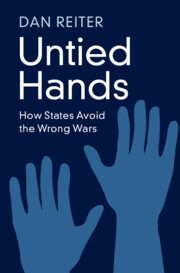Book contents
- Untied Hands
- Frontispiece
- Untied Hands
- Copyright page
- Dedication
- Contents
- Tables
- Acknowledgments
- 1 Introduction
- 2 Keeping Hands Untied to Avoid the Wrong War
- 3 Brinkmanship
- 4 The Absence of Brinkmanship Success
- 5 The Flexibility of Alliance Commitments
- 6 The Flexibility of America’s Cold War Alliances
- 7 Tripwire Force Deployments
- 8 Leaders without Reason and Machines without Souls
- 9 Conclusions
- Index
9 - Conclusions
Published online by Cambridge University Press: 03 June 2025
- Untied Hands
- Frontispiece
- Untied Hands
- Copyright page
- Dedication
- Contents
- Tables
- Acknowledgments
- 1 Introduction
- 2 Keeping Hands Untied to Avoid the Wrong War
- 3 Brinkmanship
- 4 The Absence of Brinkmanship Success
- 5 The Flexibility of Alliance Commitments
- 6 The Flexibility of America’s Cold War Alliances
- 7 Tripwire Force Deployments
- 8 Leaders without Reason and Machines without Souls
- 9 Conclusions
- Index
Summary
This chapter briefly summarizes the central argument of the book: states do not tie hands to make commitments to go to war more credible. It shows how the argument sheds light on the causes of war, that the risks of crises inadvertently escalating to war are much lower than many fear, suggesting a complete reassessment of crisis stability. It also discusses how states communicate with each other, if they do not tie hands. Next, it applies the argument to the Ukraine War, demonstrating how the insight that states do not tie hands helps explain several aspects of the Ukraine War, including why the war has not escalated, Ukraine is not a NATO member, the US withdrew advisors from Ukraine just prior to the war, and others. Last, the chapter considers this puzzle: If these tying hands ideas first developed by Thomas Schelling lack even anecdotal empirical support, why have they endured in scholarly and policy discussions for decades? Why do any ideas endure, past the point when the weight of evidence suggested they should be discarded?
Information
- Type
- Chapter
- Information
- Untied HandsHow States Avoid the Wrong Wars, pp. 231 - 247Publisher: Cambridge University PressPrint publication year: 2025
